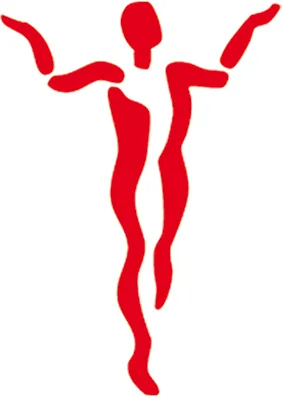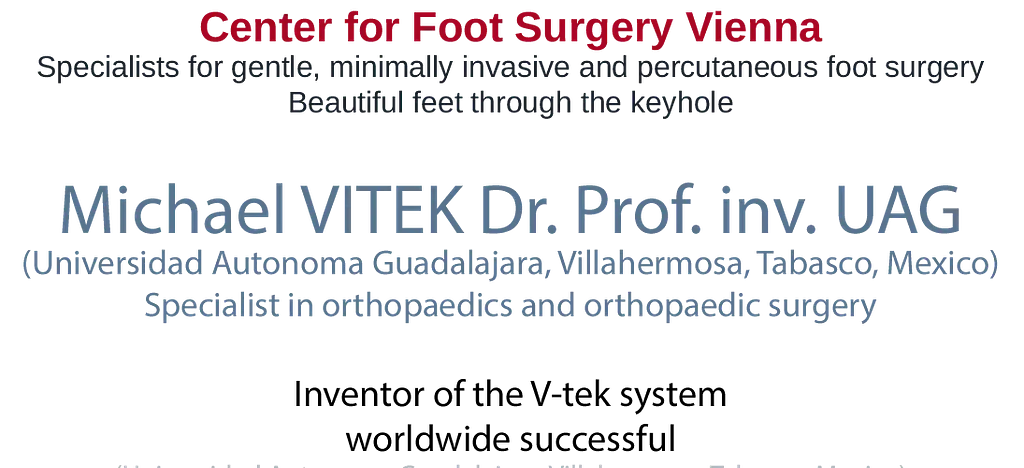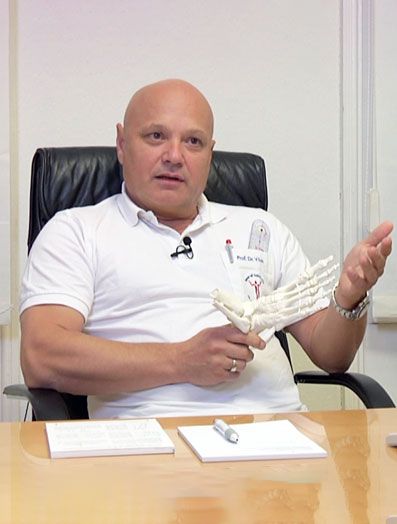Hallux limitus & Hallux Rigidus
Stiff big toe, arthritis of the big toe, abrasion of the big toe joint
The problem here is not the deformity itself or its degree of development, but the abrasion or even destruction of the metacarpophalangeal joint of the big toe, which results in increasing pain and interferes with ambulation when walking or makes it even impossible.
We distinguish four stages that reflect the degree of arthritis shown by the X-rays
- In stage I, we provide a conservative treatment.
Special insoles and physiotherapy. - In stages II and possibly III, a joint-preserving surgery can be performed.
The osteophytes (bone spurs) are removed (Cheilectomy) and if possible the first metatarsal head is placed towards the ground (with a bone cut).
Joint-preserving surgery
Here is an example of the Cheilectomy in connection with an improvement of the toes' positioning. The big toe is straightened and also set upwards so that the ambulation is improved (Akin and Moberg surgery method).
A patient with hallux rigidus, she has pain in both big toe joints. A regular rolling is no longer possible. Deformity and pain in both second toes, at the end joints a massive outward deformity, which is also caused by the hallux.
The patient really wants to wear high heels again after surgery. I try to dissuade her.
X-ray: Severe hallux rigidus stage 3 on both sides and outward deformity of the big toe, and second toes in the end joints.
Very poor mobility due to the deformed and swollen big toe joint. The very poor range of motion is demonstrated in the right picture. Pain during normal walking, putting weight on the big toe is no longer possible, instead evasive movements by the outer sides of the foot are necessary, which can lead to knee, hip and back pain.
The big toe and the second toes have just been straightened on both sides, and the big toes also made very movable, by greatly removing the deposited bone spurs and bone lips, and the big toes were placed upwards.
Here the excellent range of motion is demonstrated immediately after the end of surgery.
This is not a photo montage: After just one week, still with stitches, the lady stood on tiptoes, has no swelling or pain, and wore - contrary to my recommendation - normal footwear.
After a short time she was even wearing her high heels. Also this is not my recommendation - but it was possible.
I saw that Lady years later, because of an other orthopaedic problem - the toes were still nice and excellent in function.
Joint stiffening operation - arthtrodesis
We treat the stage III arthritis in the big toe joint either still with the Cheilectomy (see above) or with a subcapital osteotomy (bone cut and placement of the metatarsal head towards the ground to improve the forces).
Sometimes the stiffening of the joint is the best choice.
Hallux rigidus stage IV is always treated with the stiffening method (arthrodesis).
"Joint stiffening" always sounds terrible. But when I tell the patient that the pain will disappear permanently, and that both the cosmetics and the functions will be restored, it always brightens the moods. Patients can resume almost all sports and wear most of the shoes after the surgery.
Advantages at a glance:
- Freedom from pain
- Normal walking possible
- Permanent solution
- Well suited for running and other sports
The disadvantages are:
- Ballet dancing, rock climbing and sports in which the big toe needs to be clawed may be difficult
- very High-heels are not possible
Unfortunately there are few therapeutical alternatives in painful hallux rigidus stage IV with a chance of success.
Options:
- 1st option:
Keller-Brandes operation: Removal of the joint, together with the base of the proximal phalanx. Cons: short big toe. Results are not predictable. - 2nd option:
Artificial big toe joint. Cons: Does not last long. Re-operations almost impossible. The solution is again the stiffening, but it is a lot more difficult. - 3rd option:
Valenti operation method. This is a modified Brandes method. Good compromise for ladies who want to wear High-heels despite of a severe osteoarhritis. Results are not as predictable as the arthrodesis but still a good solution.
Examples:
This is a dorsal plate and for further stabilisation we use an oblique plantar screw. In most cases it is not necessary to remove the hardware lateron.
Below you see a slimmer type of ostesynthesis material, which we use now:
The new plates are very slim and stiff. They can be left in place. In rare cases they disturb the soft tissue, then we remove the material with a small operation.
The blue arrow shows the area of the former destroyed joint (Arthrosis). Now, after joint synthesis, there is a new built solid bone. The foot can be loaded and sports are possible without any pain. The foot is in an excellent shape.
The foot is in an excellent shape.
The foot can be loaded and sports are possible without any pain
Examples of repairs of corrections of hallux rigidus after failed treatment elsewhere
First case:
Here is an example of a failed joint replacement at the metatarsophalangeal joint: The prostheses are fixed, but the patient has severe pain with every step. The toe is just wobbling. The joint is severely inflamed.
The solution was very extensive: The removal of the prosthesis, and a bone loss of 12 mm. That would mean a short and functionless toe in case of stiffening without an extension, apart from the optics. We therefore conducted a lenghtening and stiffening operation (Extensional arthrodesis).
Second Case:
Condition following the Brandes surgery: After a short time the pain came back and the motion of the toe disapeared, so that a reoperation was necessary. Since bone parts had been removed during the first operation and the toe was significantly shortened, we had to transplant autologeous bone graft from the heel. The fixation was performed with a long plate.
The result was very satisfying.



